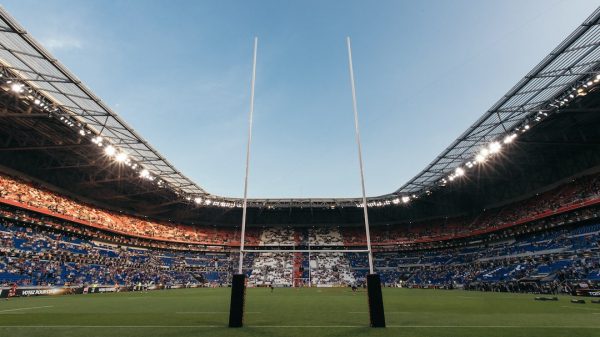American football and architecture have a long-standing relationship that goes beyond the game itself. American football stadiums are not just venues for sporting events; they are iconic structures that hold a significant place in American culture. These stadiums have become symbols of cities and regions, representing their identity and pride. The design and construction of these stadiums have evolved over time, reflecting the changing trends in architecture and technology. American football stadiums have also had a profound impact on urban planning, economic development, and the environment. In this article, we will explore the connection between American football and architecture, examining the history, design elements, influence on urban planning, role of technology, sustainability efforts, economic and social impact, comparison to other sports venues, and the future of American football stadiums.
A Brief History of American Football Stadiums in the United States
American football stadiums have come a long way since the early 20th century. In the early years of the sport, games were played in open fields or makeshift venues with limited seating capacity. As the popularity of American football grew, so did the need for proper stadiums to accommodate larger crowds. The first purpose-built stadium for American football was Harvard Stadium in 1903, which set the standard for future stadium designs.
Over the years, several key historical stadiums emerged that left a lasting impact on American football and architecture. One such stadium is Soldier Field in Chicago, which was built in 1924 and is known for its iconic neoclassical design. Another significant stadium is Lambeau Field in Green Bay, Wisconsin, home to the Green Bay Packers since 1957. Lambeau Field is renowned for its “frozen tundra” playing surface and its unique bowl-shaped design.
The Design Elements of American Football Stadiums and their Impact on Architecture
American football stadiums are characterized by several design elements that make them distinct from other sports venues. One of the most prominent features is the seating bowl, which is designed to provide optimal sightlines for spectators. The bowl shape allows for a large number of seats to be arranged in a circular or oval pattern, ensuring that every seat has a clear view of the field.
Another important design element is the roof structure. Many modern American football stadiums feature retractable roofs, allowing games to be played in any weather conditions. The roof also helps create a sense of enclosure and intimacy within the stadium, enhancing the overall fan experience.
The use of materials is also a significant aspect of American football stadium design. Many stadiums incorporate steel and glass elements, giving them a modern and sleek appearance. The choice of materials not only affects the aesthetics but also influences the structural integrity and sustainability of the stadium.
The impact of these design elements extends beyond sports venues. The open-air seating bowl concept has been adapted in other architectural projects, such as amphitheaters and concert venues. The use of retractable roofs has also been implemented in arenas and convention centers, allowing for flexible use of space.
The Influence of American Football Stadiums on Urban Planning
American football stadiums play a crucial role in urban planning, often serving as catalysts for urban development and revitalization. These stadiums are not just standalone structures; they are part of larger complexes that include parking facilities, retail spaces, restaurants, and entertainment venues. The development of these complexes creates opportunities for economic growth and job creation.
One example of the impact of American football stadiums on urban planning is the AT&T Stadium in Arlington, Texas. The construction of this stadium led to the development of the surrounding area, known as the “Entertainment District.” The district includes hotels, restaurants, shopping centers, and other entertainment venues, attracting visitors and generating revenue for the city.
Another notable example is the Mercedes-Benz Stadium in Atlanta, Georgia. This stadium is located in the heart of downtown Atlanta and has played a significant role in the revitalization of the surrounding area. The stadium’s design incorporates sustainable features, such as a retractable roof that collects rainwater for reuse, further contributing to the city’s sustainability goals.
The Role of Technology in Modern American Football Stadiums and Architecture
Technology has played a crucial role in shaping modern American football stadiums and their impact on architecture. From state-of-the-art video screens to advanced sound systems, technology has transformed the fan experience and the design of these stadiums.
One of the most significant technological advancements in modern stadiums is the use of LED video screens. These screens are larger, brighter, and more vibrant than traditional scoreboards, providing fans with an immersive viewing experience. The screens can display live game footage, replays, statistics, and interactive content, enhancing the overall fan engagement.
Another technological innovation is the integration of wireless connectivity throughout the stadium. This allows fans to access Wi-Fi networks and mobile applications, providing real-time updates, interactive features, and social media integration. The use of technology also extends to stadium operations, with advanced security systems, ticketing systems, and crowd management tools.
The impact of technology on architecture goes beyond American football stadiums. The use of LED screens and wireless connectivity has been adopted in other architectural projects, such as shopping malls, airports, and public spaces. These technologies have become integral to creating engaging and interactive environments for people.
The Sustainability of American Football Stadiums and their Impact on the Environment
In recent years, there has been a growing emphasis on sustainability in the design and construction of American football stadiums. Stadiums are large-scale structures that consume significant amounts of energy and resources. Efforts have been made to make stadiums more sustainable and environmentally friendly.
One example is Levi’s Stadium in Santa Clara, California, which is home to the San Francisco 49ers. The stadium was designed with sustainability in mind, incorporating features such as solar panels, water-efficient fixtures, and a green roof. These initiatives have helped reduce the stadium’s carbon footprint and promote environmental stewardship.
Another example is U.S. Bank Stadium in Minneapolis, Minnesota, which hosted Super Bowl LII in 2018. The stadium is LEED Gold certified, meaning it meets strict standards for energy efficiency and sustainability. It features a rainwater collection system, energy-efficient lighting, and a green roof that helps regulate temperature and reduce stormwater runoff.
The sustainability efforts of American football stadiums have had a broader impact on the construction industry. The use of renewable energy sources, water conservation measures, and sustainable materials has become more prevalent in architectural projects. Stadiums have become showcases for sustainable design practices, inspiring other industries to adopt similar strategies.
The Economic and Social Impact of American Football Stadiums on their Surrounding Communities
American football stadiums have a significant economic and social impact on their surrounding communities. These stadiums attract large crowds of fans who spend money on tickets, concessions, merchandise, and parking. This influx of visitors stimulates the local economy, supporting businesses and creating job opportunities.
Stadiums also serve as venues for other events beyond football games, such as concerts, conventions, and community gatherings. These events bring additional revenue to the surrounding area and contribute to the cultural vibrancy of the community.
Moreover, American football stadiums have a social impact on their communities by fostering a sense of pride and unity. They become gathering places where people from diverse backgrounds come together to support their team and celebrate their shared love for the sport. The stadiums often become symbols of the community’s identity and heritage.
Comparing American Football Stadiums to Other Sports Venues and their Influence on Architecture
While American football stadiums share some similarities with other sports venues, they also have distinct characteristics that set them apart. Compared to baseball stadiums or basketball arenas, American football stadiums are larger in scale and can accommodate a higher number of spectators. The seating bowl design and the need for a large playing field contribute to the size of these stadiums.
American football stadiums also differ in terms of their architectural style and aesthetics. Many football stadiums feature modern and sleek designs, incorporating steel, glass, and other contemporary materials. The emphasis is often on creating an immersive and visually striking experience for fans.
The influence of American football stadiums on architecture extends beyond sports venues. The design elements and technological advancements seen in these stadiums have influenced the construction of other large-scale structures, such as concert halls, convention centers, and exhibition spaces. The integration of technology, the use of sustainable materials, and the focus on creating engaging environments have become common practices in architectural projects.
The Future of American Football Stadiums and their Potential Influence on Architecture
The future of American football stadiums holds exciting possibilities for both the sport and architecture. As technology continues to advance, stadiums will incorporate more interactive features, such as augmented reality and virtual reality experiences. These technologies will enhance the fan experience and create new opportunities for engagement.
Sustainability will also play a significant role in the future of American football stadiums. Stadiums will continue to prioritize energy efficiency, waste reduction, and sustainable materials. The integration of renewable energy sources, such as solar power and wind turbines, may become more prevalent.
Furthermore, the design of American football stadiums may become more flexible to accommodate a variety of events beyond sports. Stadiums will be designed with multi-purpose functionality in mind, allowing for seamless transitions between different types of events.
The Enduring Legacy of American Football Stadiums on American Architecture
American football stadiums have left an enduring legacy on American architecture. These iconic structures have become symbols of cities and regions, representing their identity and pride. The design elements, technological advancements, sustainability efforts, economic impact, and social significance of these stadiums have influenced not only sports venues but also other architectural projects.
The relationship between American football and architecture is a testament to the power of design and its ability to shape our built environment. As the future of American football stadiums unfolds, we can expect to see further innovation and creativity in their design and construction. These stadiums will continue to be cultural landmarks that bring people together and leave a lasting impact on American architecture.
FAQs
What is the article about?
The article is about the impact of American Football stadiums on American architecture.
What is American Football?
American Football is a sport played between two teams of eleven players on a rectangular field with goalposts at each end.
How many American Football stadiums are there in the United States?
There are over 100 American Football stadiums in the United States.
What is the history of American Football stadiums?
American Football stadiums have evolved over time, from simple wooden bleachers to modern, state-of-the-art facilities with retractable roofs and high-tech video screens.
How do American Football stadiums influence American architecture?
American Football stadiums have had a significant impact on American architecture, influencing the design of other types of buildings such as airports, convention centers, and museums.
What are some examples of American Football stadiums that have influenced American architecture?
Some examples of American Football stadiums that have influenced American architecture include the Mercedes-Benz Stadium in Atlanta, the AT&T Stadium in Dallas, and the U.S. Bank Stadium in Minneapolis.
What are some of the design features of modern American Football stadiums?
Modern American Football stadiums often feature retractable roofs, high-tech video screens, luxury suites, and other amenities designed to enhance the fan experience.
What is the economic impact of American Football stadiums?
American Football stadiums can have a significant economic impact on the surrounding area, generating jobs and revenue for local businesses. However, there is debate over whether the public funding of stadiums is a wise investment.

































































































Recent Comments